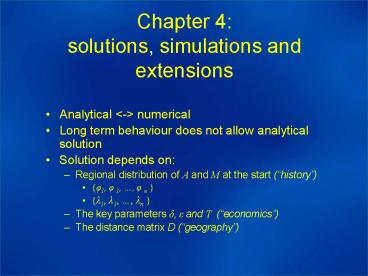Chapter 4: solutions, simulations and extensions - PowerPoint PPT Presentation
1 / 14
Title:
Chapter 4: solutions, simulations and extensions
Description:
Figure 4.1 The relative real wage in region 1. 2-region base scenario. 0,97. 1. 1,03. 0 ... Suppose all manufacturing agglomerated into region 1 ... – PowerPoint PPT presentation
Number of Views:15
Avg rating:3.0/5.0
Title: Chapter 4: solutions, simulations and extensions
1
Chapter 4solutions, simulations and extensions
- Analytical lt-gt numerical
- Long term behaviour does not allow analytical
solution - Solution depends on
- Regional distribution of A and M at the start
(history) - f1, f 1, , f n
- ?1, ?1, , ?n
- The key parameters d, e and T (economics)
- The distance matrix D (geography)
2
Numerical solution
- Yr d ?r Wr fr ( 1 d)
- Ir ( Ss ?s Trs1-e Ws1-e )1/(1-e)
- Wr ( Ss Ys Trs1-e Ise-1 )1/e
- wr Wr Ir-d
- 5. d?1/?1 ?(w1 ?)
- For two regions
- Set W1 W2 1
- Calculate Y and I from 1-2
- Calculate W from 3
- Recalculate Y, I and W
- Stop when for all regions r Wr /Wr lt 1 s
(break-off condition) - short term equilibrium
- Calculate wr and ?r from 4-5
- Stop when for all regions r wr /? lt 1 s
(break-off condition) - Long term term equilibrium
3
Simulation example for two regions
Table 4.1 Base
-
scenario parameter configuration, 2 regions
d
g
0.4
0.4
L
1
r
0.8
b
0.8
f
f
0.5
1
2
a
s
T
1.7
0.08
0.0001
e 1/(1-?) 5
4
Result of 59 simulations of the two region model
with varying values of ?1 ?2 1 ?1 using the
parameters of table 4.1
Figure 4.1 The relative real wage in region 1
T 1.7
ws Ws Is-d
stable
unstable
5
Figure 4.2 The impact of transport costs
Higher T spreading more likely
6
The impact of some parameters
Higher ? spreading more likely Lower ? less
substitution possible -gt nr of varieties more
important -gt agglomeration advantage
7
The impact of some parameters
Low d spreading more likely High d M-goods more
important in the budget -gt agglomeration
advantage for local welfare
8
Fig 4.3 The Tomahawk diagram
S1 (T1,81)
1
?1
B (T1,63)
0,5
0
S0 (T1,81)
T
Unstable equilibria
Stable equilibria
Break point point where the spreading
equilibrium changes from stable to unstable
9
Result of 59 simulations of the two region model
with varying values of ?1 ?2 1 ?1 using the
parameters of table 4.1
Figure 4.1 The relative real wage in region 1
T 1.7
ws Ws Is-d
stable
unstable
10
No black hole condition and break point
- Suppose all manufacturing agglomerated into
region 1 - Solution W11, Y1(1d)/2, Y2(1-d)/2, I11,
I2T, w11 - Workers will only move to region 2 when w2 gt 1
- w2e f(T)(1d)/2T-(?d)e (1- d)/2T(?-d)e gt
1 - With increasing T first term becomes small but
second term only becomes large when ?gtd - Define g(T) 1-T1-e /1 T1-e 1 -
d(1?)/(d2?) - B Tbreak when g(T)1
11
w2
12
Simulations with a race track economy (4.5.6)
Figure 4.12 The racetrack economy number of
locations R
13
Figure 4.12 continued
14
Figure 4.10 continued






























